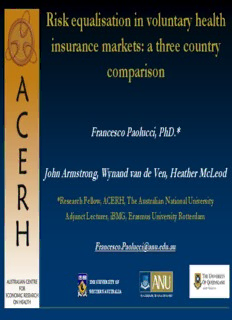
Francesco Paolucci, PhD.* John Armstrong, Wynandvan de Ven PDF
Preview Francesco Paolucci, PhD.* John Armstrong, Wynandvan de Ven
Risk equalisation in voluntary health insurance markets: a three country comparison Francesco Paolucci, PhD.* John Armstrong, Wynandvan de Ven, Heather McLeod *Research Fellow, ACERH, The Australian National University Adjunct Lecturer, iBMG, Erasmus University Rotterdam [email protected] THE UNIVERSITY OF WESTERN AUSTRALIA Special Issue in ‘Health Policy’ Outline: 1. Editorial: „Risk equalisation in voluntary health insurance markets‟ (Armstrong, Paolucci, van de Ven); 2. „Risk equalisation and voluntary health insurance markets: The case of Australia‟ (Connelly, Paolucci, Butler, Collins); 3. „Risk equalisation and voluntary health insurance in Ireland‟ (Armstrong); 4. „Risk equalisation in the South African voluntary health insurance market‟ (McLeod, Grobler); 5. Risk equalisation in voluntary health insurance markets: a three country comparison. Agenda 1. Overview of health financing in the 3- countries; 2. Voluntary private health insurance (VPHI) and risk-equalisation (RE) in the 3- countries; 3. Conclusions and discussion. Part 1. Overview of health financing in the 3-countries Australia (1) Mix of public-private financing & deliveryof health services: • Public health insurance (Medicare, 1984). (68% of THE). • Out-of-pocket payments. (24% of THE). • Competitive VPHI. (8% of THE). Australia (2) Medicare (1984): • Tax funded universal mandatory coverage; • „Free‟ treatment as a public patient in a public hospital; • Subsidies for private medical services (Medicare Benefits Schedule) and pharmaceuticals (Pharmaceutical Benefits Scheme). Australia (3) Competitive VPHI: • Supplementary coverage for (parts of) the costs of services not covered by Medicare (e.g. hospital charges levied by private hospitals); • Duplicate coverage for the costs of services (partly) covered by Medicare; • Non-substitutive; • Individual-based insurance; Out-of-pocket payments: • VPHI-Deductibles, POS-copayments. Ireland (1) Public/private mix of funding & delivery of healthcare (almost identical to Australia): - Tax-funded public health insurance scheme; - VPHI market; - Out of pocket expenditures. Ireland (2) VPHI marketcommenced in 1957 with establishment of Vhi Healthcare & provides: • Duplicative coverage to universal entitlement of public hospitals*; • Substitutive GP-care coverage for non- Medical Card holders; • Supplementary coverage. • Employer based schemes (60%) or directly by individuals. South Africa (1) Public/private financing & delivery of healthcare: Public sector (40% of THE) Private sector (60% of THE) Universal tax-funded with allocated budgets for VPHI market (1889) known as „medical public healthcare facilities. schemes‟ since 1967 covering on a voluntary basis 15% of the population (i.e. high-income groups) 64% of the population depends on it for all A further 21% of the population use private conventional healthcare services GP and pharmacies on OOP-basis and for the rest relies on the public scheme Salaried staff FFS Care is virtually „free‟ at the point of service for Deductibles and copayments unemployed and low-income people (e.g. user charges with exemption policies)
Description: